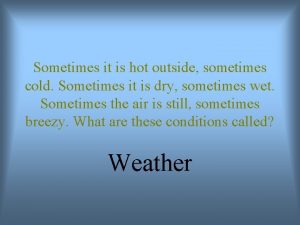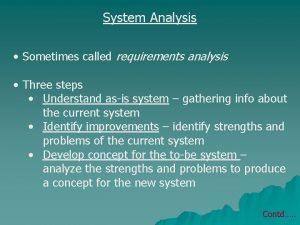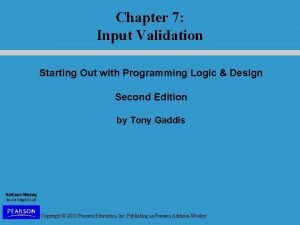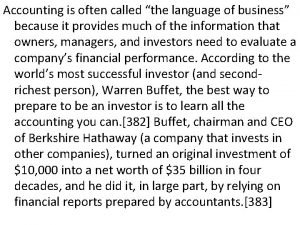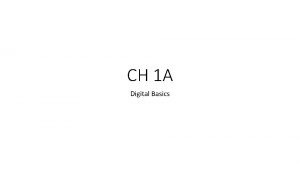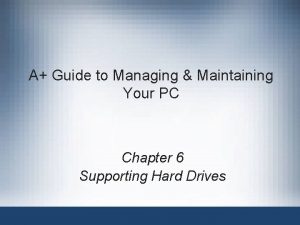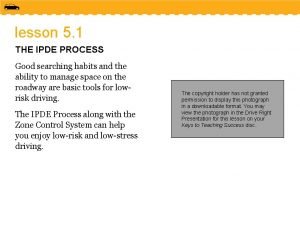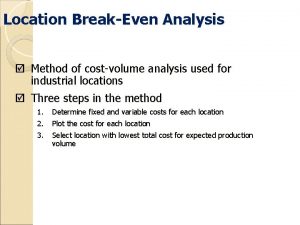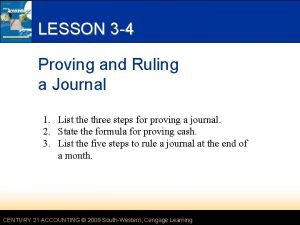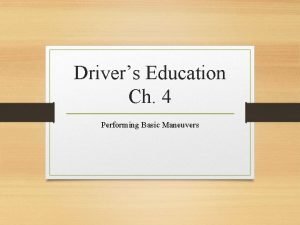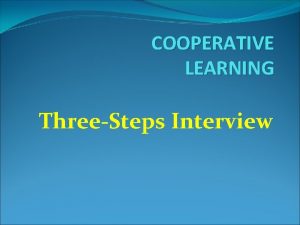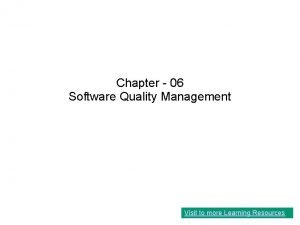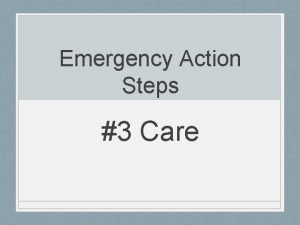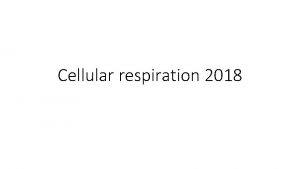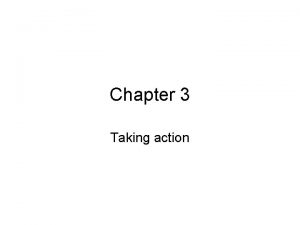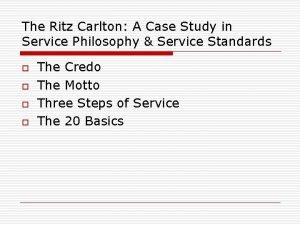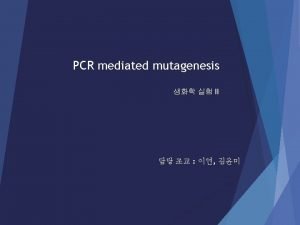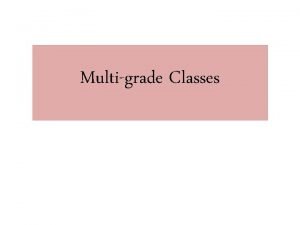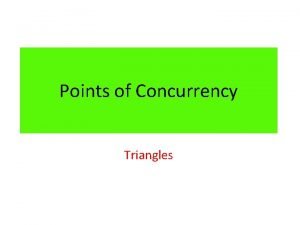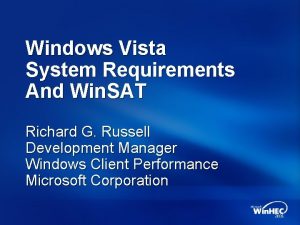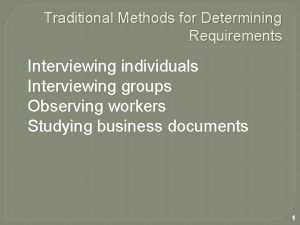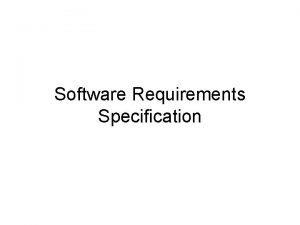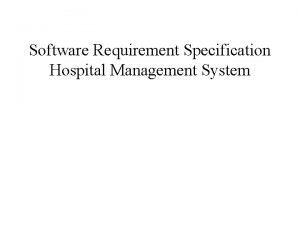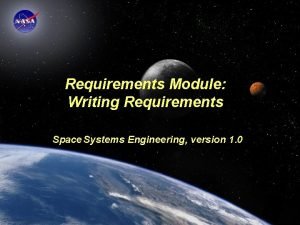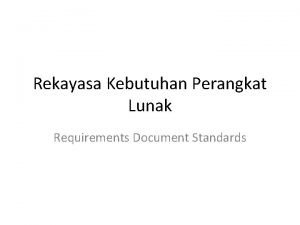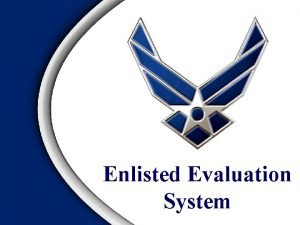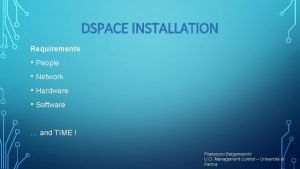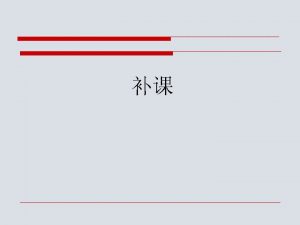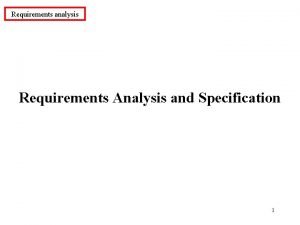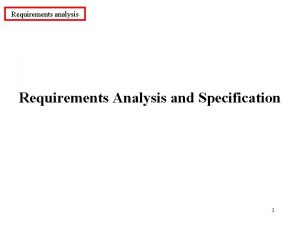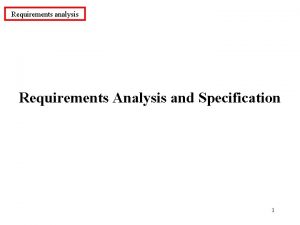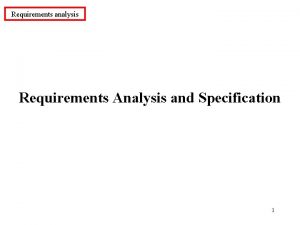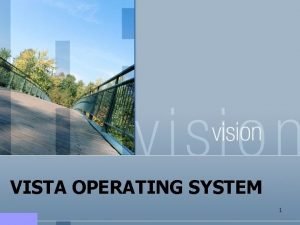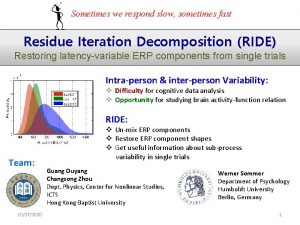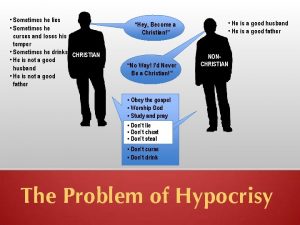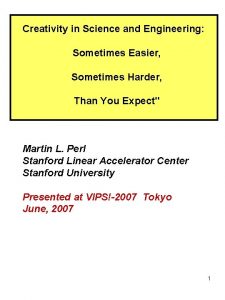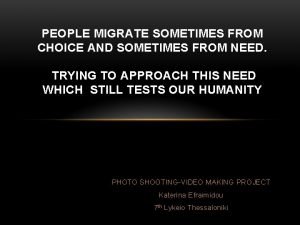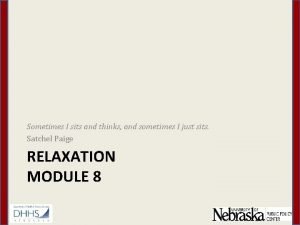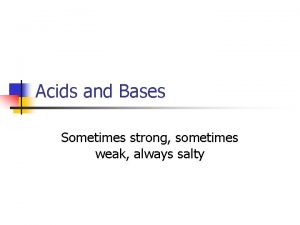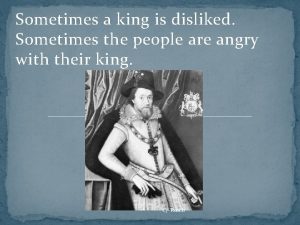System Analysis Sometimes called requirements analysis Three steps


































- Slides: 34

System Analysis • Sometimes called requirements analysis • Three steps • Understand as-is system – gathering info about the current system • Identify improvements – identify strengths and problems of the current system • Develop concept for the to-be system – analyze the strengths and problems to produce a concept for the new system Contd…. .

• The steps are tightly coupled and are often iterative • The analysis phase ends with a basic plan – analysis plan for the to-be system that is described via a process model and a data model • So, analysis includes info gathering thro’ interviews, DFD modeling, and ER Modeling

The Analysis Process: • Analyzing IS requirements is both a business task and an IT task • Early days’ presumption – SA is an IT job – did not address the true business needs • Then business experts did the SA – automation of existing inefficient systems without using IT to fullest • Ideal approach – balance the business expertise of the users and systems expertise of the analysts • General ideas for the to-be system was developed in the initiation phase Contd…. .

• The product of the analysis phase is a system concept for the to-be system • This concept is then refined in the design phase and then built and delivered in the implementation phase • A business process is simply a set of activities that are performed to achieve some goal • E. g. , a typical store • While developing ISs, it is important to understand the scope of the business process under study – entire store, or just one component

Three Analysis Strategies: • Business Process Automation (BPA) – using IT to do some of the work, basic operation is unchanged, least impact on business • Business Process Improvement (BPI) – moderate changes w. r. t. organizational operations using IT, or to copy competitors • Business Process Reengineering (BPR) – changing the fundamental way in which organization operates, making major changes taking advantage of new business ideas and IT Contd…. .

• No one approach is better than others? • Regardless of the analysis strategy the project flows thro’ the three fundamental steps • Understanding the as-is system • Identifying improvements, and • Developing concept for the to-be system

Understanding the As-Is System: • In most cases, the system under development replaces an existing system • So, first understand it’s strengths and weaknesses • Apply good info gathering techniques • If the as-is system is computerized, review the analysis and design docs of the previous system • Develop a detailed process model and data model Contd…. .

• Caution • Do not to jump into conclusions about the new system • Temptation to focus only on what the users want • Users may know what they’d like in a new system • That may not truly reflect what they really • Analyst may have a predetermined system concept • Focus only on understanding the as-is system, whether computerized or not need

Identifying Improvement Opportunities: • Identify ways to improve the current system • Again, info-gathering techniques are used • Requires technology skills and business expertise • Analyst and/or external consultant and/or users will work on identifying improvements

Developing the To-Be System Concept: • Analysts and users develop the components for the to-be system • The system concept starts as a fuzzy set of possible improvement ideas • These are gradually worked & reworked into a viable concept for the to-be system • The system concept is reasonably well understood • A business process model and a data model are created Contd…. .

• Analysis ends with a system proposal for the new system • Presents an overview of one or more recommended alternatives • Presents a vision for the new system and outlines its basic design • Each alternative will present – outline of the new system, process model, and a data model • Analysts will develop revised work plan for each alternative, will again examine the expected costs and benefits, and present a more detailed version of the feasibility analysis Contd…. .

• The system proposal is presented to the approval committee • A walk-through may be conducted for clear understanding of the alternatives • With the go ahead the project transitions from analysis into the design phase

Outline of a Typical System Proposal: 1. Table of contents 2. Executive summary: A summary of all the essential info in the proposal so a busy executive can read it quickly and decide what parts of the plan to read in more depth 3. System request: The original system request that initiated the project, with revisions as needed after the analysis phase 4. Work Plan: The original work plan, revised after completion of the analysis phase Contd…. .

5. Analysis strategy: A summary of the activities performed during the analysis phase, such as the analyses performed, and how the info was gathered (e. g. , the questionnaires used, the persons interviewed) 6. Recommended system: A summary of the concept for the recommended system, as well as the key facts justifying the decision. A discussion on the alternatives considered is also included 7. Feasibility analysis: A revised feasibility using the info from the analysis phase Contd…. .

8. Process model: A set of process models and descriptions for the to-be system, including the process model of the current as-is system that will be replaced 9. Data model: A set of data models and descriptions for the to-be system 10. Appendices: Contain additional material relevant to the proposal, might include results of questionnaire survey, interviews, industry reports and statistics, possible hardware and software considerations

Analysis Strategy – Business Process Automation (BPA): • BPA leaves the existing business process essentially the same but puts in place a new system that makes the processes more efficient • Automates an existing manual process, or • Improves an existing computerized system • Simplifies interactions with the system • Provides improved efficiency to users • Least impact on jobs, fundamental business process remains unchanged, new tools may be used

Understanding the As-Is System: Do the same thing in better ways • Extensive info gathering § Observation of the system in operation § Interviews with all stakeholders § Review current system’s documentation • Detailed process modeling • Detailed data modeling

Identifying Improvements: With BPA, most of the improvement opportunities come from problems in the current system. Two general techniques to identify improvements –

• Problem Analysis § Straightforward BPA analysis technique § Identify problems with the as-is system from users and managers § Come out with possible solutions § Most changes tend to solve problems rather than capitalize on opportunities § Provide only minor improvements in business value

• Root cause analysis § Problem analysis is solution oriented based on assumptions § Solutions may not always be appropriate § In root cause analysis instead of the symptoms, the root causes of problems are addressed

Developing the To-Be System Concept: • Minimal info gathering • To-be process and data models are very close to as-is process and data models • Revise the as-is process model into the to-be model • Revise as-is data model into the to-be model

Analysis Strategy – Business Process Improvement (BPI): • Improve business processes by introducing moderate changes that are incremental or evolutionary in nature • The to-be system implements these changes and creates value not only by increasing efficiency but also by changing the what is done

Understanding the As-Is System: Some of the business processes will be quite different. • Extensive info gathering • Detailed process modeling • Detailed data modeling

Identifying Improvement Opportunities: • BPI focuses on business improvement • Ideas can come from “problem analysis” or “root cause analysis” but more powerful techniques are used • Duration analysis – detailed examination of amount of time taken to process inputs to outputs in the as-is business process • Total time can be 10 to 100 times longer than the sum of the parts (say for home mortgage) • Think in terms of process integration and process parallelization Contd…. .

• Activity-based costing – examines the cost of each major process rather than the time § Identify the costly processes, and focus improvement efforts on them • Informal benchmarking – fairly common for customer facing business processes § Study other organizations’ processes • Formal benchmarking – thorough and costly benchmarking strategy § Team of analysts study processes of many organizations

Developing the To-Be System Concept: • Moderate info gathering • Revise the as-is process model into the to-be model • Revise as-is data model into the to-be model

Analysis Strategy– Business Process Reengineering (BPR): • Fundamental rethinking and radical redesign of business processes to achieve dramatic improvements in critical, contemporary measures of performance, such as cost, quality, service, and speed – Michael Hammer and James Champy, Reengineering the corporation • Appealing but risky and time-consuming

Understanding the As-Is System: • Minimal info gathering • Basic understanding of the essence of the as-is system

Identifying Improvement Opportunities: • Complete rethinking of the business processes, creatively • Six BPR techniques • Outcome analysis – from customers’ perspective • Insurance company • Breaking assumptions – how to break each and every business rule, and benefit by doing so • Non-sufficient Funds in customers’ account Contd…. .

• Technology analysis – application of new technology • Achieve JIT inventory thro’ announcing production schedule • Activity elimination • Proxy benchmarking – similar to informal benchmarking, except the target of the benchmarking is a different industry having similar structure • Process simplification – separate complex operations (exceptions) from the normal operations • A separate process handles complex inputs

Developing the To-Be System Concept: • Very different to-be process • Requires extensive info gathering after deciding on the changes • Detailed to-be process model • Detailed to-be data model

Developing an Analysis Plan: • The plan for activities that the project team will conduct during the analysis phase • Outlines what activities will exactly be done in each of the analysis phases • Which analysis strategy will be pursued • No strategy is better than others • Combination of strategies may be used • Decided by the project sponsor Contd…. .

• Project team provide important inputs to the sponsor • BPA may be used on most of the business processes and BPI on some key parts • Strengths and weaknesses of analysis strategies on four parameters • Potential business value • Project cost • Breadth of analysis – boundary of analysis • Risk

BPA BPI BPR Potential Business Value Low/Mod Moderate High Project Cost Low/Mod High Breadth of Analysis Narrow/Mod Very broad Risk Low/Mod Very high
 They say it only takes a little faith
They say it only takes a little faith Sometimes you win some
Sometimes you win some Sometimes sweet sometimes sour
Sometimes sweet sometimes sour Sometimes cold sometimes hot
Sometimes cold sometimes hot Analysis is sometimes called
Analysis is sometimes called Cite at least 5 axial steps and 5 locomotor steps
Cite at least 5 axial steps and 5 locomotor steps Input validation loop python
Input validation loop python Why is accounting referred to as language of business
Why is accounting referred to as language of business Plain, unformatted text is sometimes called ascii text.
Plain, unformatted text is sometimes called ascii text. Sometimes called jbod
Sometimes called jbod What are the three steps of the zone control system?
What are the three steps of the zone control system? Locational break even analysis steps
Locational break even analysis steps Requirements modeling in system analysis and design
Requirements modeling in system analysis and design List the three steps for proving a journal
List the three steps for proving a journal 3. turn
3. turn Three step interview kagan
Three step interview kagan A key concept of quality control is that all work products
A key concept of quality control is that all work products Emergency actions steps
Emergency actions steps Overall reaction of cellular respiration
Overall reaction of cellular respiration What are the three emergency action steps
What are the three emergency action steps Credo
Credo The three steps of polymerase chain reaction
The three steps of polymerase chain reaction Classes with three or more grade levels are called
Classes with three or more grade levels are called Point of concurrency
Point of concurrency Windows vista system requirements
Windows vista system requirements Traditional methods for determining system requirements
Traditional methods for determining system requirements Structuring system requirements
Structuring system requirements System requirements specification
System requirements specification High level requirements
High level requirements Use case diagram for hospital management system
Use case diagram for hospital management system System requirements document
System requirements document Requirements writing for system engineering
Requirements writing for system engineering Ieee guide to software requirements specifications
Ieee guide to software requirements specifications Enlisted evaluation system
Enlisted evaluation system Dspace install
Dspace install



